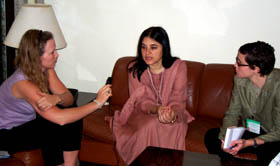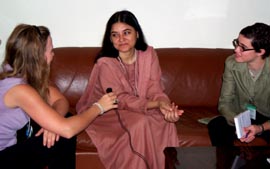 |
| Mark
Simmons, Whale and Dolphin Conservation Society, opened the side event
and succinctly characterized whales as highly vulnerable, little studied
and little understood. Whales are highly migratory mammals, acutely
threatened by chemical and noise pollution, climate change, by-catch,
and hunting (called "research" in certain countries). He
noted many of the items on the CITES COP-11 agenda revolve around
whaling and trade, and questioned when conservation will be addressed.
|
 |
|
 Frank
Cipriano, University of San Francisco, overviewed what can and cannot
be accomplished with DNA testing, and what mechanisms are in place
to monitor whaling. He highlighted the value of DNA testing in identifying
species of processed whale products on the market. Products have
been detected in Japan from illegally taken whale species such as
the Humpback. He presented results of commercial whale studies between
1993-1999 which found that, in Japan, consumption of North and South
Minkes, taken through "research" remained constant and that the
amount of dolphin and porpoise met sold as "whale meat" increased
during this period. Frank
Cipriano, University of San Francisco, overviewed what can and cannot
be accomplished with DNA testing, and what mechanisms are in place
to monitor whaling. He highlighted the value of DNA testing in identifying
species of processed whale products on the market. Products have
been detected in Japan from illegally taken whale species such as
the Humpback. He presented results of commercial whale studies between
1993-1999 which found that, in Japan, consumption of North and South
Minkes, taken through "research" remained constant and that the
amount of dolphin and porpoise met sold as "whale meat" increased
during this period.
Cipriano stressed
that market surveys using DNA testing cannot control illegal trade,
but only demonstrate that it happened. He said those in support
of downlisting whale species make false claims that DNA analysis
is available to provide effective whaling monitoring. In many cases,
there is not adequate taxonomic understanding to identify a species,
for example, in the case of the Minke Whale, there are two or three
species but there is a lack of taxonomic information to determine
this precisely.
He drew attention
to a recent workshop on molecular identification that recommended:
mandatory sampling of whales that enter commerce; controlled access
to genetic databases; improvement in identifying samples to populations;
improve areas of taxonomic uncertainty; and submission of Minke
Whale survey results to the IWC Scientific Committee for scientific
evaluation. In closing, he cautioned against CITES proposals to
downlist whale species that assert DNA registers and market surveys
are in place.
|
| Dr.
Ron Orienstein, International Wildlife Coalition, discussed an Australian
proposal to place a healthy dugong population in Appendix II to avoid
split listing of species, in accordance with COP Resolution 9/24,
that could provide loopholes dangerous to populations in decline.
He noted the Secretariat opposed this resolution as the criteria for
inclusion in Appendix I requires that the individual population, not
the greater species, be threatened. |
 |
Press
briefing: Report on the "one-off" sale of ivory
and poaching
 The
Environmental
Investigation Agency (EIA), released a new
report entitled "Lethal Experiment" showing how
a decision to allow an experimental sale of ivory has led to renewed
elephant poaching. The report uncovers evidence of increased poaching,
particularly in Zimbabwe and Kenya in the past two years. Julian
Newman, EIA Senior Investigator (right) highlighted China as a
major destination for illegal ivory shipments and described the
findings of his undercover investigations in the People's Republic. The
Environmental
Investigation Agency (EIA), released a new
report entitled "Lethal Experiment" showing how
a decision to allow an experimental sale of ivory has led to renewed
elephant poaching. The report uncovers evidence of increased poaching,
particularly in Zimbabwe and Kenya in the past two years. Julian
Newman, EIA Senior Investigator (right) highlighted China as a
major destination for illegal ivory shipments and described the
findings of his undercover investigations in the People's Republic.
"Unless
the southern elephant populations are put back on Appendix I,
CITES risks repeating the mistakes made in the 1980s when elephant
poaching and ivory smuggling thrived and elephants declined across
much of their range," said EIA Chairman Allan Thornton (center).
He said that we've proven that no amount of trade is compatible
with conservation, and that the solution must come from reducing
demand to zero.
Clare Penny,
EIA Campaigner (left), outlined some of EIA recommendations at
CITES, which include: support for the Kenyan and Indian proposal
to transfer all elephant populations to Appendix I; opposition
to proposals for annual quotas of ivory, elephant hide or live
elephant sales by Zimbabwe, Botswana and Namibia; and opposition
to any proposal by South Africa to downlist its elephant population.
The release of the report was purposely timed to coincide with
CITES-11.
The EIA,
a non-profit environmental organization based in London and Washington,
DC, campaigns against the illegal trade in endangered species,
smuggling of ozone-depleting chemicals, and the illegal timber
trade.
|
|
Miscellaneous:
|
|
|
Visiting
the ENB office: Kimo Goree, Managing Editor of the ENB (left) explains
the methodology of the publication to Willem Wijnstekers, CITES
Secretary-General (second from the left) and Jim Armstrong, Deputy
Secretary General of CITES (far right). Seated in front of their
computers are ENB writers Leanne Burney and Mark Shulman, and, standing,
Laura Ivers.
|
 |
IN
THE BREEZEWAYS
The controversial suggestion to place trade sanctions on India to
spur its tiger conservation efforts, has left delegates speculating
as to whether this is serious, and, if so, if the logic isn't just
a bit off. Some question whether the sanction wouldn't be counterproductive,
punishing India instead of providing much needed financial assistance
to address poachers. There is also a sentiment that punishing the
consumers of tiger products would be more appropriate, but many speculate
that power politics prohibit such action. Some developing countries
have hinted that application of trade sanctions in response to a lack
of capacity could isolate such Parties and encourage them to abandon
CITES. |
|








